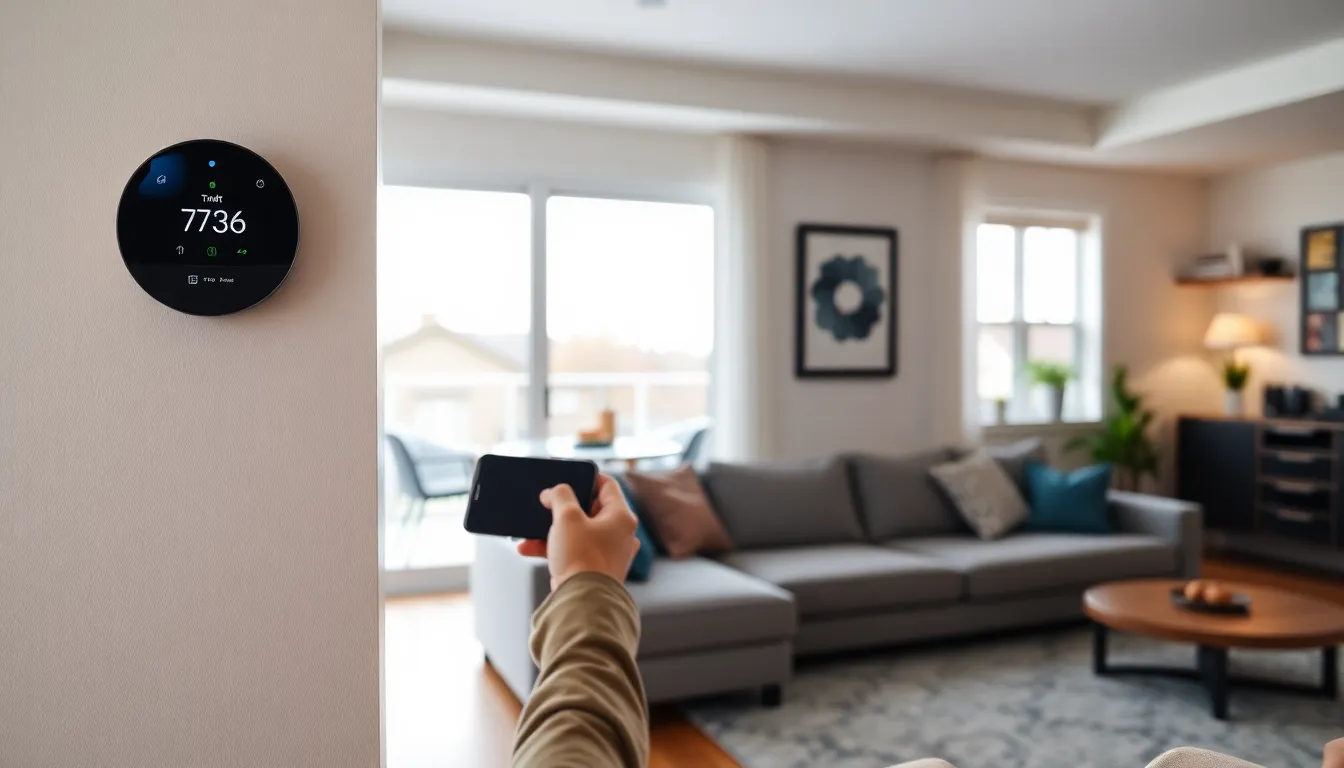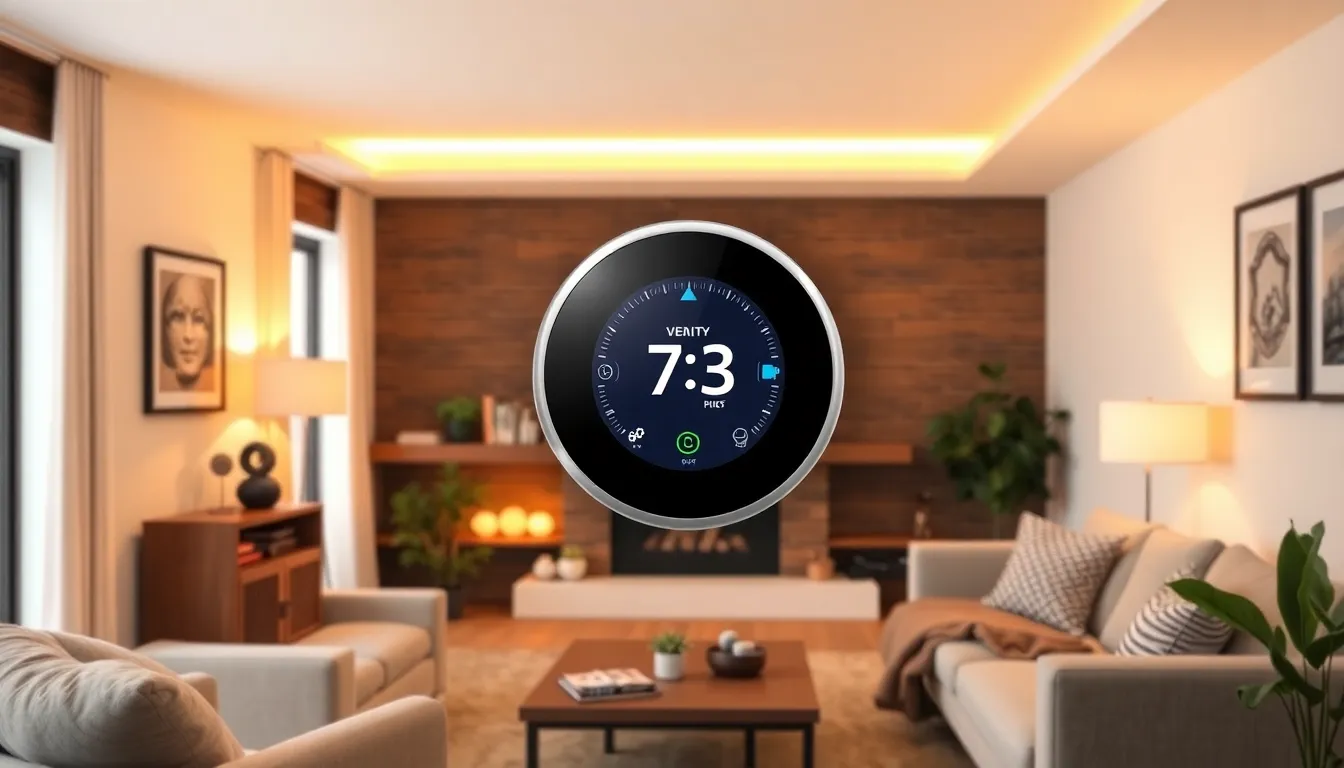In a world where even toasters can be smart, why shouldn’t your thermostat join the party? Smart thermostats are the unsung heroes of home technology, blending convenience with energy savings. Imagine controlling your home’s temperature from your couch, your bed, or even while pretending to work at the coffee shop. It’s like having a personal climate assistant that knows your comfort preferences better than your best friend.
These nifty gadgets don’t just make your life easier; they also help you save money on energy bills. With features like learning algorithms and remote access, they adjust to your schedule and keep your home cozy without breaking the bank. So why settle for an ordinary thermostat when you can upgrade to a device that’s as smart as your smartphone? Embrace the future of home comfort and let your thermostat do the thinking for you.
Table of Contents
ToggleOverview of Smart Thermostats
Smart thermostats represent a significant advancement in climate control technology. These devices connect to Wi-Fi, enabling users to adjust home temperatures remotely using smartphones or tablets. Integration with home automation systems enhances their functionality, allowing for seamless operation alongside other smart devices.
Learning algorithms distinguish smart thermostats from traditional models. These algorithms analyze user behavior and preferences, automatically adjusting settings to optimize comfort. Over time, many users notice reduced energy consumption as thermostats adapt to their schedules.
Energy savings are a key benefit. According to the U.S. Department of Energy, households can save approximately 10 to 15 percent on heating and cooling costs with programmable models. Smart thermostats take this further by providing real-time data and insights into energy usage patterns.
User-friendly interfaces streamline the adjustment process. Touchscreens, mobile apps, and voice commands simplify temperature settings. Many smart thermostats are compatible with virtual assistants, enabling easy temperature adjustments through simple voice commands.
Reporting capabilities offer users insight into their energy consumption. Weekly or monthly reports highlight energy usage, allowing for informed decision-making regarding energy habits. Many manufacturers emphasize features that promote greater energy efficiency, further incentivizing the use of these devices.
Enhanced home comfort results from the personalized approach of smart thermostats. Customized schedules cater to individual preferences, ensuring optimal temperature at all times. By adopting smart thermostats, users gain both convenience and efficiency while prioritizing home energy management.
Benefits of Smart Thermostats


Smart thermostats offer several benefits that enhance comfort and efficiency in homes. These devices significantly improve energy management, leading to various savings and conveniences.
Energy Efficiency
Energy-efficient heating and cooling relies on smart thermostats to optimize settings based on user behavior. Learning algorithms adjust temperatures automatically, reducing unnecessary energy use. Real-time data on energy consumption helps users identify patterns and areas for improvement. According to the U.S. Department of Energy, households can save approximately 10 to 15 percent on heating and cooling costs by utilizing smart thermostats. Through remote access, these devices allow for adjustments during away times, ensuring systems operate only when needed. Enhanced efficiency leads to a reduced carbon footprint, contributing to environmental sustainability.
Cost Savings
Substantial cost savings result from adopting smart thermostats in residential settings. Monthly utility bills shrink as these devices learn individual preferences and schedule adjustments accordingly. Without constant manual changes, efficiency tends to increase, translating into lower heating and cooling expenses. Reports show that smart thermostat users often reduce spending on energy by up to 15 percent. Seasonal adjustments cater to heating and cooling demands, further minimizing costs throughout the year. Over time, the initial investment in smart technology pays for itself through notable savings.
Convenience and Control
Convenience stems from the user-friendly interfaces that smart thermostats provide. Touchscreens and voice command options facilitate easy adjustments without needing additional tools. Remote access through smartphones or tablets empowers users to manage home climates from anywhere. These devices allow for personalized settings tailored to individual preferences, enhancing comfort levels. Automated scheduling simplifies temperature control, eliminating the need for manual changes. Home automation compatibility enables seamless integration with other smart devices, offering a cohesive control system.
Types of Smart Thermostats
Several types of smart thermostats cater to different needs and preferences. Each type offers unique features that enhance home climate control.
Learning Thermostats
Learning thermostats adapt to user behavior over time. They observe patterns in heating and cooling preferences, adjusting automatically to maintain optimal comfort. These devices utilize advanced algorithms to learn daily schedules, suggesting temperature changes based on past behavior. Many users appreciate the intuitive setup process, which often requires minimal input. According to studies, learning thermostats can lead to energy savings of up to 15 percent. Their real-time data monitoring provides insights on energy usage, helping homeowners make informed decisions.
Programmable Thermostats
Programmable thermostats allow users to set specific heating and cooling schedules. These devices enable customized temperature settings for different times of the day, maximizing efficiency. Users can program temperatures for weekdays, weekends, or even specific hours, offering flexibility according to lifestyle. Many models feature easy-to-navigate interfaces, making programming a straightforward task. Savings potential with programmable models can reach up to 10 to 15 percent on annual energy bills, according to the U.S. Department of Energy. Remote access capabilities also enhance user control, allowing adjustments from anywhere.
Popular Smart Thermostat Brands
Several brands dominate the smart thermostat market, each offering unique features and benefits.
Nest
Nest offers a user-friendly design with a sleek interface that appeals to many homeowners. This smart thermostat learns user preferences, adjusting schedules automatically to enhance comfort and efficiency. With its ability to integrate seamlessly into Google Home ecosystems, users enjoy convenient voice control. Data shows that Nest users can save around 10 to 15 percent on energy bills. The Nest Leaf feature encourages energy-saving settings, promoting more sustainable usage habits.
Ecobee
Ecobee stands out with its unique room sensors, which help manage hot and cold spots throughout the home. Users can direct comfort where they need it most, optimizing heating and cooling. The integration with smart home systems, including Amazon Alexa and Apple HomeKit, broadens its functionality. Ecobee users report energy savings of up to 23 percent due to its intelligent scheduling features. Additionally, the real-time energy usage reports provide valuable insights for informed decisions.
Honeywell
Honeywell combines reliability and innovative technology in its smart thermostat lineup. Their models feature easy-to-read displays, making adjustments straightforward. Users appreciate the flexible scheduling options that adapt to individual lifestyles. Enhanced geofencing capabilities ensure energy-efficient cooling or heating when users arrive or leave home. Honeywell thermostats can save users around 10 to 15 percent on annual heating and cooling costs, proving beneficial for budget-conscious households.
Smart thermostats are transforming how homeowners manage their climate control systems. With their ability to learn user preferences and adapt accordingly they not only enhance comfort but also contribute to significant energy savings. By integrating with home automation systems these devices streamline functionality and offer unprecedented control from anywhere.
Investing in a smart thermostat is a step toward a more efficient and eco-friendly home. As technology continues to evolve these devices will only become more sophisticated making it easier for users to optimize their energy consumption and reduce their utility bills. Embracing this technology is not just a choice but a smart move for a sustainable future.





